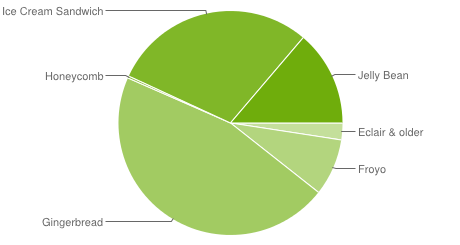The popularity of Android 4.x is growing
 The popularity of Android 4.x is growing steadily. So, the source - developer.android.com - reports a share of all versions of 4.x ( Ice Cream Sandwich and the latest Jelly Bean ) in 42.6% ( Ice Cream Sandwich has a share of 29% separately, and Jelly Bean - 13.6 %). Versions 2.3.x ( Gingerbread ) have a share of 45.6% , while half a year ago this figure was 60.6%.
The popularity of Android 4.x is growing steadily. So, the source - developer.android.com - reports a share of all versions of 4.x ( Ice Cream Sandwich and the latest Jelly Bean ) in 42.6% ( Ice Cream Sandwich has a share of 29% separately, and Jelly Bean - 13.6 %). Versions 2.3.x ( Gingerbread ) have a share of 45.6% , while half a year ago this figure was 60.6%.In dynamics, it looks even more interesting: the graph shows that Jelly Bean gained its interest in less than six months.

The AppBrain site shows even more interesting results: here versions 2.3.x ( Gingerbread ) have a share of 39.9% , and the share of versions 4.x ( Ice Cream Sandwich and Jelly Bean ) is 44.1% - that is, in a non-native store 4.x already overtaken 2.3.x.
')
It can be assumed that this is partly due to the fact that alternative stores are used by more advanced users, who are sufficiently advanced to know about the existence of such stores. Advanced users, on the other hand, seek to flash their phones with the latest firmware possible.
On the other hand, recently, Chinese noname-manufacturers have begun to release more phones with native Google applications cut out from the firmware (including Google Play ), which in this case does not have advantages over alternative markets.
In dynamics, it looks like this:

The share of Gingerbread is rapidly falling, the share of Ice Cream Sandwich is also, albeit more slowly, the share of Jelly Bean is growing for two.
This suggests that, despite the still high percentage of using versions 2.3.x , the share of lower versions is already only about 10% and continues to fall, so they are no longer decisive and minSdkVersion in developed applications can be safely set to 9 or ten.
Source: https://habr.com/ru/post/168925/
All Articles